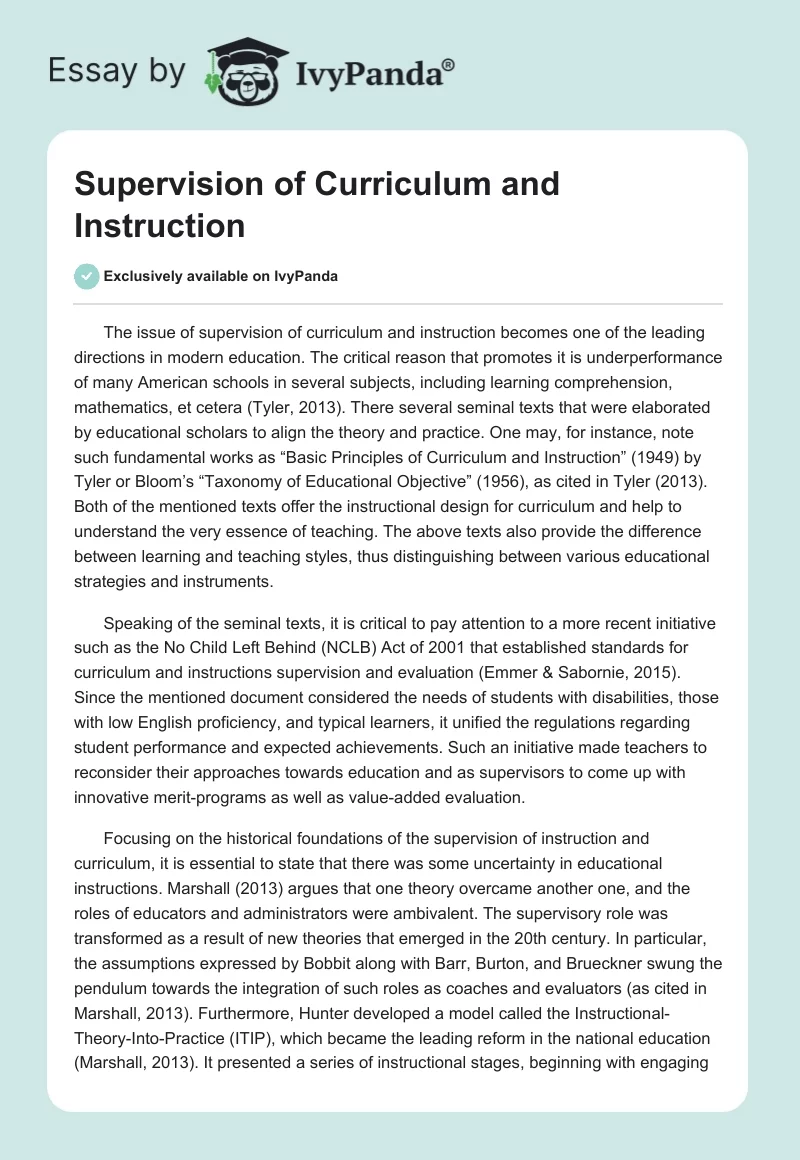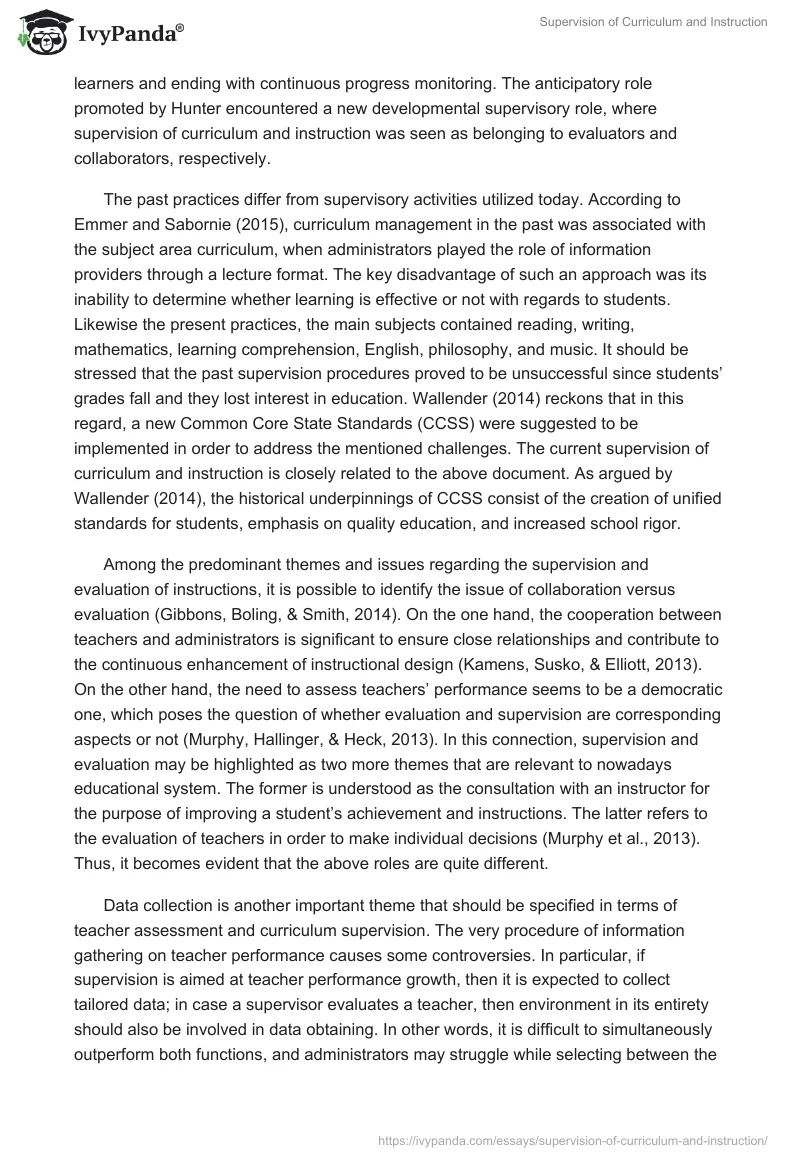The issue of supervision of curriculum and instruction becomes one of the leading directions in modern education. The critical reason that promotes it is underperformance of many American schools in several subjects, including learning comprehension, mathematics, et cetera (Tyler, 2013). There several seminal texts that were elaborated by educational scholars to align the theory and practice. One may, for instance, note such fundamental works as “Basic Principles of Curriculum and Instruction” (1949) by Tyler or Bloom’s “Taxonomy of Educational Objective” (1956), as cited in Tyler (2013). Both of the mentioned texts offer the instructional design for curriculum and help to understand the very essence of teaching. The above texts also provide the difference between learning and teaching styles, thus distinguishing between various educational strategies and instruments.
Speaking of the seminal texts, it is critical to pay attention to a more recent initiative such as the No Child Left Behind (NCLB) Act of 2001 that established standards for curriculum and instructions supervision and evaluation (Emmer & Sabornie, 2015). Since the mentioned document considered the needs of students with disabilities, those with low English proficiency, and typical learners, it unified the regulations regarding student performance and expected achievements. Such an initiative made teachers to reconsider their approaches towards education and as supervisors to come up with innovative merit-programs as well as value-added evaluation.
Focusing on the historical foundations of the supervision of instruction and curriculum, it is essential to state that there was some uncertainty in educational instructions. Marshall (2013) argues that one theory overcame another one, and the roles of educators and administrators were ambivalent. The supervisory role was transformed as a result of new theories that emerged in the 20th century. In particular, the assumptions expressed by Bobbit along with Barr, Burton, and Brueckner swung the pendulum towards the integration of such roles as coaches and evaluators (as cited in Marshall, 2013). Furthermore, Hunter developed a model called the Instructional-Theory-Into-Practice (ITIP), which became the leading reform in the national education (Marshall, 2013). It presented a series of instructional stages, beginning with engaging learners and ending with continuous progress monitoring. The anticipatory role promoted by Hunter encountered a new developmental supervisory role, where supervision of curriculum and instruction was seen as belonging to evaluators and collaborators, respectively.
The past practices differ from supervisory activities utilized today. According to Emmer and Sabornie (2015), curriculum management in the past was associated with the subject area curriculum, when administrators played the role of information providers through a lecture format. The key disadvantage of such an approach was its inability to determine whether learning is effective or not with regards to students. Likewise the present practices, the main subjects contained reading, writing, mathematics, learning comprehension, English, philosophy, and music. It should be stressed that the past supervision procedures proved to be unsuccessful since students’ grades fall and they lost interest in education. Wallender (2014) reckons that in this regard, a new Common Core State Standards (CCSS) were suggested to be implemented in order to address the mentioned challenges. The current supervision of curriculum and instruction is closely related to the above document. As argued by Wallender (2014), the historical underpinnings of CCSS consist of the creation of unified standards for students, emphasis on quality education, and increased school rigor.
Among the predominant themes and issues regarding the supervision and evaluation of instructions, it is possible to identify the issue of collaboration versus evaluation (Gibbons, Boling, & Smith, 2014). On the one hand, the cooperation between teachers and administrators is significant to ensure close relationships and contribute to the continuous enhancement of instructional design (Kamens, Susko, & Elliott, 2013). On the other hand, the need to assess teachers’ performance seems to be a democratic one, which poses the question of whether evaluation and supervision are corresponding aspects or not (Murphy, Hallinger, & Heck, 2013). In this connection, supervision and evaluation may be highlighted as two more themes that are relevant to nowadays educational system. The former is understood as the consultation with an instructor for the purpose of improving a student’s achievement and instructions. The latter refers to the evaluation of teachers in order to make individual decisions (Murphy et al., 2013). Thus, it becomes evident that the above roles are quite different.
Data collection is another important theme that should be specified in terms of teacher assessment and curriculum supervision. The very procedure of information gathering on teacher performance causes some controversies. In particular, if supervision is aimed at teacher performance growth, then it is expected to collect tailored data; in case a supervisor evaluates a teacher, then environment in its entirety should also be involved in data obtaining. In other words, it is difficult to simultaneously outperform both functions, and administrators may struggle while selecting between the mentioned issues. Therefore, it is critical for administrators to clearly identify and share their purpose of lesson observation with a teacher being either evaluated or coached. Since both roles may be accomplished by one person, teachers may feel reluctant to build relationships with them.
Speaking of the foundations of the supervision of instruction and curriculum, one should also pinpoint current and future trends in the identified field. Focusing closer on teacher evaluations, one may note the theme of value-added assessment. In the recent article, Berliner (2013) states that specific tests exist to assess students’ achievement, and those who have higher grades should be educated by more skilled teachers, while poorer teachers should have students with lower educational progress. In case skills and knowledge provided by teachers proved to be effective via tests, such teachers are entitled to receive rewards, while they are to be fired otherwise. Berliner (2013) argues that such an approach cannot ensure fair and valid teacher performance evaluation since several factors such as student engagement, attitudes, school environment, and so on may affect their grades.
As for future trends, Liebtag (2013) states that CCSS is already adopted by plenty of schools and it would continue being the fundamental document in the given field. One may anticipate that it would be helpful in calibrating curriculum and instruction supervision. CCSS may be considered as the most complete standard-based initiative that may be enhanced in the future to meet the changing needs of students and teachers and advance the education ion a larger scale. Another trend that is worth turning one’s attention to is associated with aligning instruction, curriculum, and student learning. Grant and Gareis (2013) reckon that teacher-made assessment is likely to guide teachers in elaborating their own classroom tests to evaluate student performance. The above developing trend seems to be integrative to learning and teaching, thus serving as a comprehensive and supplementary tool to the supervision of curriculum and instruction.
References
Berliner, D. C. (2013). Problems with value-added evaluations of teachers? Let me count the ways! The Teacher Educator, 48(4), 235-243.
Emmer, E., & Sabornie, E. (2015). Handbook of classroom management: Research, practice, and contemporary issues (2nd ed.). New York, NY: Routledge.
Gibbons A.S., Boling E., & Smith K.M. (2014). Instructional design models. In Spector J., Merrill M., Elen J., Bishop M. (Eds.) Handbook of research on educational communications and technology. New York, NY: Springer.
Grant, L., & Gareis, C. (2013). Teacher-made assessments: How to connect curriculum, instruction, and student learning. New York, NY: Routledge.
Kamens, M. W., Susko, J. P., & Elliott, J. S. (2013). Evaluation and supervision of co-teaching: A study of administrator practices in New Jersey. NASSP Bulletin, 97(2), 166-190.
Liebtag, E. (2013). Moving forward with Common Core State Standards implementation: Possibilities and potential problems. Journal of Curriculum and Instruction, 7(2), 56-70.
Marshall, K. (2013). Rethinking teacher supervision and evaluation: How to work smart, build collaboration, and close the achievement gap (2nd ed.). New York, NY: John Wiley & Sons.
Murphy, J., Hallinger, P., & Heck, R. H. (2013). Leading via teacher evaluation: The case of the missing clothes? Educational Researcher, 42(6), 349-354.
Tyler, R. W. (2013). Basic principles of curriculum and instruction. Chicago, IL: University of Chicago Press.
Wallender, J. (2014). The Common Core State Standards in American public education: Historical underpinnings and justifications. Delta Kappa Gamma Bulletin, 80(4), 7-11.


